Analysis of Leadership, Management, and Operations Management
VerifiedAdded on 2021/01/02
|9
|3666
|255
Report
AI Summary
This report delves into the distinctions between leadership and management, outlining their respective roles and functions within an organization. It examines various leadership theories and models, including situational, contingency, and system leadership, providing a comprehensive overview of their key concepts. The report further explores the application of leadership and management principles within different organizational contexts, with a specific focus on Amazon's operations management. It discusses key approaches to operations management such as Six Sigma, Total Quality Management, and Just-in-Time inventory. The report also analyzes the impact of leaders and managers on operational decisions and the influence of the business environment on these decisions, offering a well-rounded perspective on the interplay of leadership, management, and operational effectiveness. The content is aimed at providing students with a comprehensive understanding of the topics.
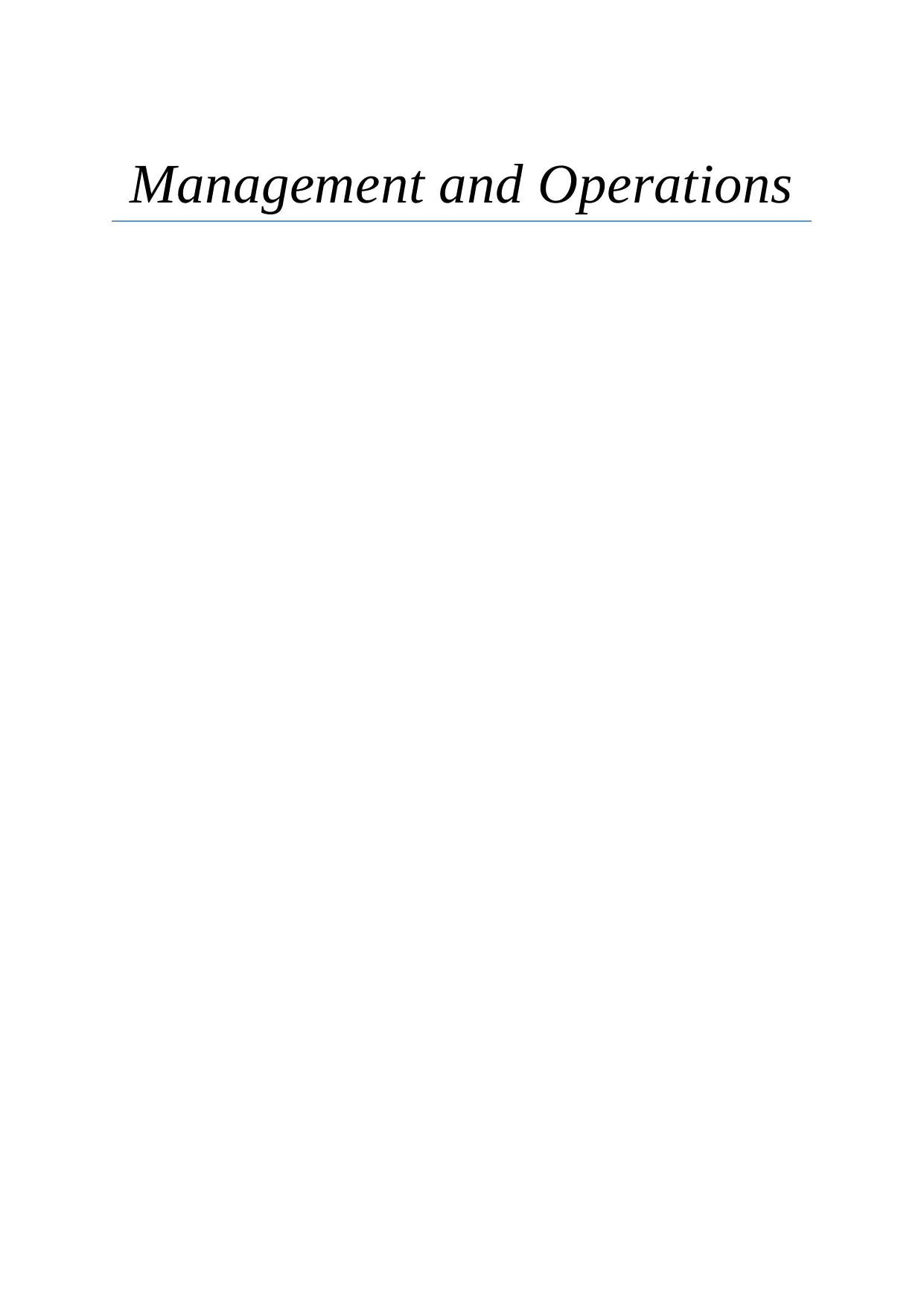
Management and Operations
Paraphrase This Document
Need a fresh take? Get an instant paraphrase of this document with our AI Paraphraser
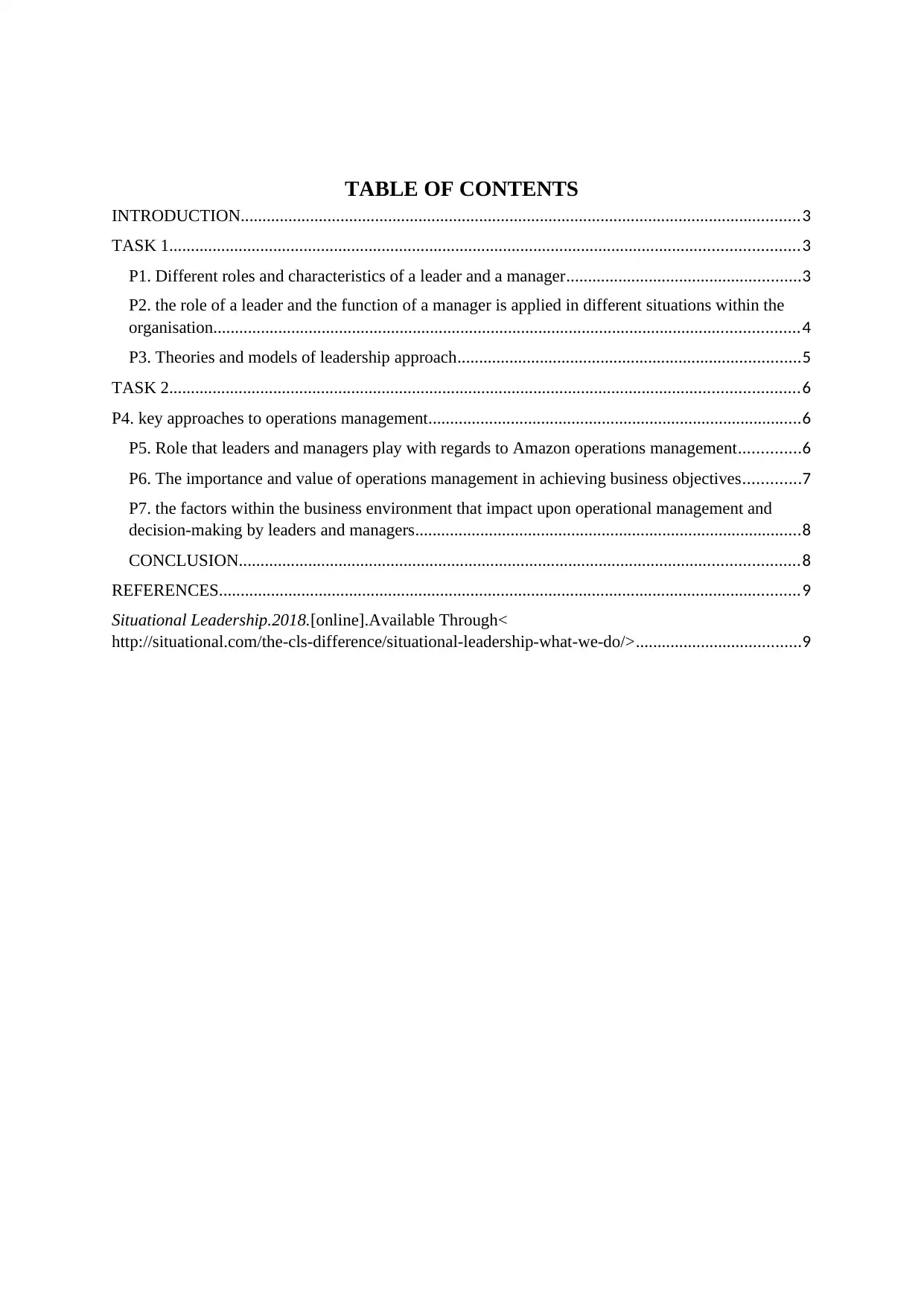
TABLE OF CONTENTS
INTRODUCTION.................................................................................................................................3
TASK 1.................................................................................................................................................3
P1. Different roles and characteristics of a leader and a manager......................................................3
P2. the role of a leader and the function of a manager is applied in different situations within the
organisation.......................................................................................................................................4
P3. Theories and models of leadership approach...............................................................................5
TASK 2.................................................................................................................................................6
P4. key approaches to operations management......................................................................................6
P5. Role that leaders and managers play with regards to Amazon operations management..............6
P6. The importance and value of operations management in achieving business objectives.............7
P7. the factors within the business environment that impact upon operational management and
decision-making by leaders and managers.........................................................................................8
CONCLUSION.................................................................................................................................8
REFERENCES......................................................................................................................................9
Situational Leadership.2018.[online].Available Through<
http://situational.com/the-cls-difference/situational-leadership-what-we-do/>......................................9
INTRODUCTION.................................................................................................................................3
TASK 1.................................................................................................................................................3
P1. Different roles and characteristics of a leader and a manager......................................................3
P2. the role of a leader and the function of a manager is applied in different situations within the
organisation.......................................................................................................................................4
P3. Theories and models of leadership approach...............................................................................5
TASK 2.................................................................................................................................................6
P4. key approaches to operations management......................................................................................6
P5. Role that leaders and managers play with regards to Amazon operations management..............6
P6. The importance and value of operations management in achieving business objectives.............7
P7. the factors within the business environment that impact upon operational management and
decision-making by leaders and managers.........................................................................................8
CONCLUSION.................................................................................................................................8
REFERENCES......................................................................................................................................9
Situational Leadership.2018.[online].Available Through<
http://situational.com/the-cls-difference/situational-leadership-what-we-do/>......................................9
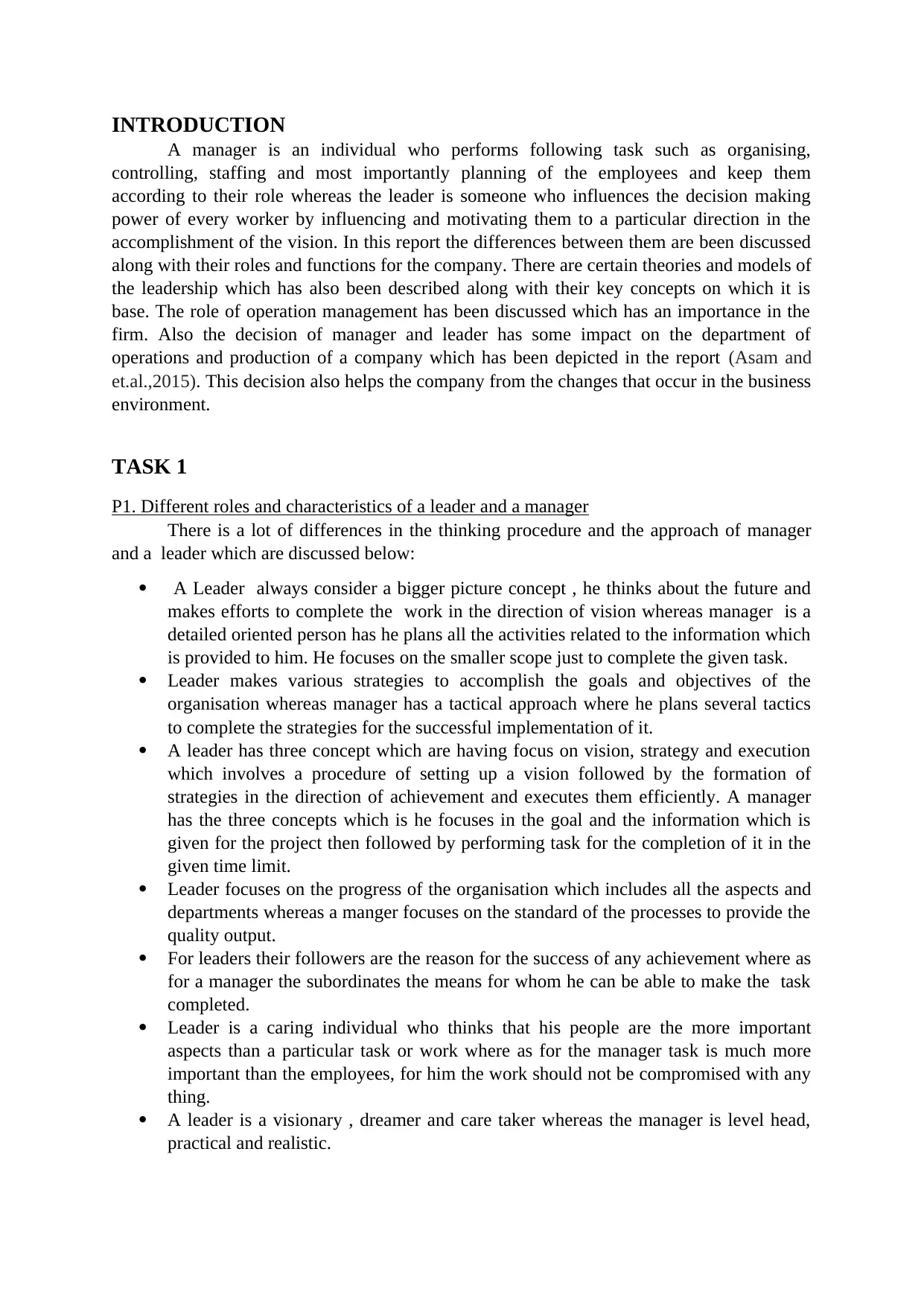
INTRODUCTION
A manager is an individual who performs following task such as organising,
controlling, staffing and most importantly planning of the employees and keep them
according to their role whereas the leader is someone who influences the decision making
power of every worker by influencing and motivating them to a particular direction in the
accomplishment of the vision. In this report the differences between them are been discussed
along with their roles and functions for the company. There are certain theories and models of
the leadership which has also been described along with their key concepts on which it is
base. The role of operation management has been discussed which has an importance in the
firm. Also the decision of manager and leader has some impact on the department of
operations and production of a company which has been depicted in the report (Asam and
et.al.,2015). This decision also helps the company from the changes that occur in the business
environment.
TASK 1
P1. Different roles and characteristics of a leader and a manager
There is a lot of differences in the thinking procedure and the approach of manager
and a leader which are discussed below:
A Leader always consider a bigger picture concept , he thinks about the future and
makes efforts to complete the work in the direction of vision whereas manager is a
detailed oriented person has he plans all the activities related to the information which
is provided to him. He focuses on the smaller scope just to complete the given task.
Leader makes various strategies to accomplish the goals and objectives of the
organisation whereas manager has a tactical approach where he plans several tactics
to complete the strategies for the successful implementation of it.
A leader has three concept which are having focus on vision, strategy and execution
which involves a procedure of setting up a vision followed by the formation of
strategies in the direction of achievement and executes them efficiently. A manager
has the three concepts which is he focuses in the goal and the information which is
given for the project then followed by performing task for the completion of it in the
given time limit.
Leader focuses on the progress of the organisation which includes all the aspects and
departments whereas a manger focuses on the standard of the processes to provide the
quality output.
For leaders their followers are the reason for the success of any achievement where as
for a manager the subordinates the means for whom he can be able to make the task
completed.
Leader is a caring individual who thinks that his people are the more important
aspects than a particular task or work where as for the manager task is much more
important than the employees, for him the work should not be compromised with any
thing.
A leader is a visionary , dreamer and care taker whereas the manager is level head,
practical and realistic.
A manager is an individual who performs following task such as organising,
controlling, staffing and most importantly planning of the employees and keep them
according to their role whereas the leader is someone who influences the decision making
power of every worker by influencing and motivating them to a particular direction in the
accomplishment of the vision. In this report the differences between them are been discussed
along with their roles and functions for the company. There are certain theories and models of
the leadership which has also been described along with their key concepts on which it is
base. The role of operation management has been discussed which has an importance in the
firm. Also the decision of manager and leader has some impact on the department of
operations and production of a company which has been depicted in the report (Asam and
et.al.,2015). This decision also helps the company from the changes that occur in the business
environment.
TASK 1
P1. Different roles and characteristics of a leader and a manager
There is a lot of differences in the thinking procedure and the approach of manager
and a leader which are discussed below:
A Leader always consider a bigger picture concept , he thinks about the future and
makes efforts to complete the work in the direction of vision whereas manager is a
detailed oriented person has he plans all the activities related to the information which
is provided to him. He focuses on the smaller scope just to complete the given task.
Leader makes various strategies to accomplish the goals and objectives of the
organisation whereas manager has a tactical approach where he plans several tactics
to complete the strategies for the successful implementation of it.
A leader has three concept which are having focus on vision, strategy and execution
which involves a procedure of setting up a vision followed by the formation of
strategies in the direction of achievement and executes them efficiently. A manager
has the three concepts which is he focuses in the goal and the information which is
given for the project then followed by performing task for the completion of it in the
given time limit.
Leader focuses on the progress of the organisation which includes all the aspects and
departments whereas a manger focuses on the standard of the processes to provide the
quality output.
For leaders their followers are the reason for the success of any achievement where as
for a manager the subordinates the means for whom he can be able to make the task
completed.
Leader is a caring individual who thinks that his people are the more important
aspects than a particular task or work where as for the manager task is much more
important than the employees, for him the work should not be compromised with any
thing.
A leader is a visionary , dreamer and care taker whereas the manager is level head,
practical and realistic.
⊘ This is a preview!⊘
Do you want full access?
Subscribe today to unlock all pages.

Trusted by 1+ million students worldwide
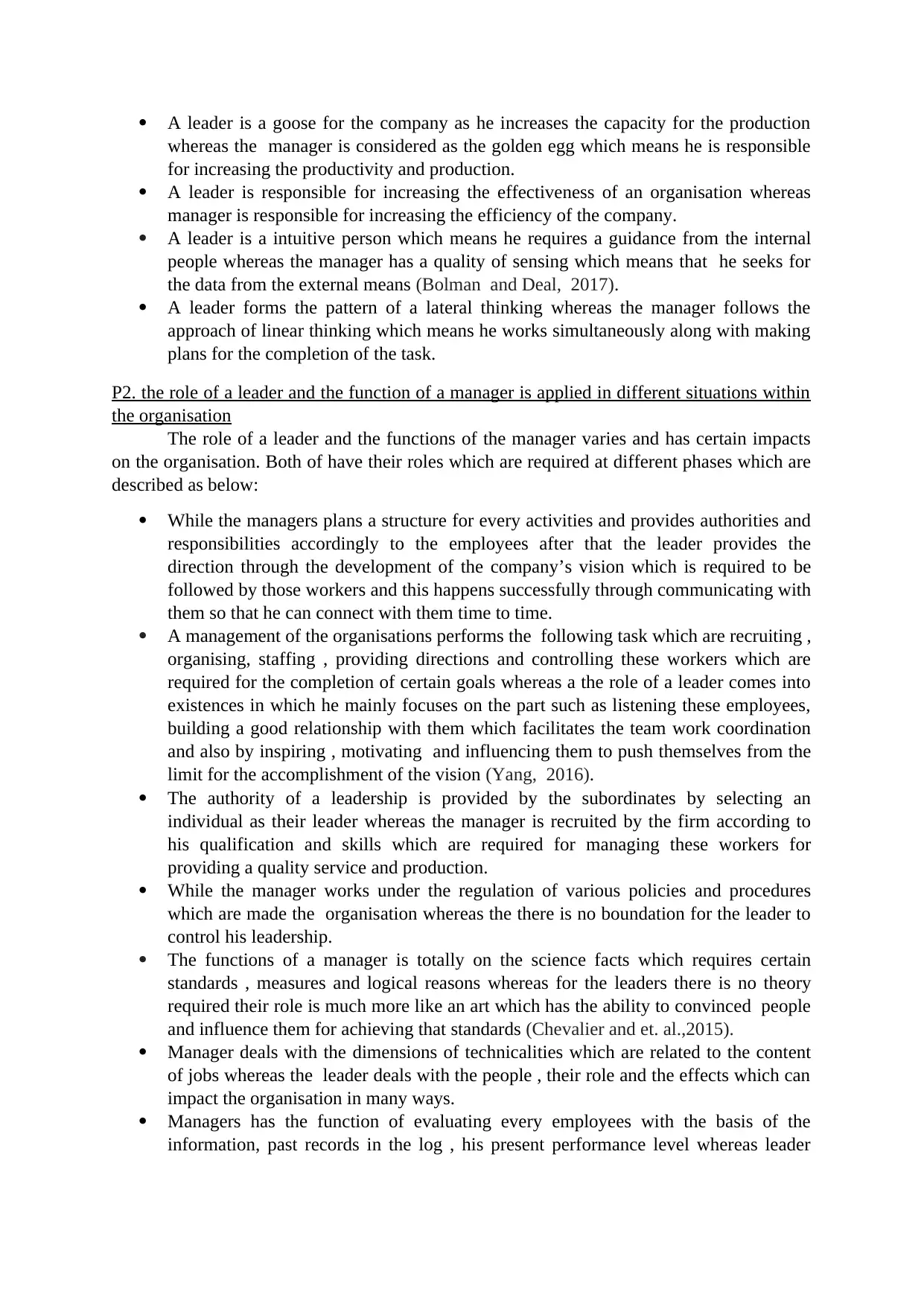
A leader is a goose for the company as he increases the capacity for the production
whereas the manager is considered as the golden egg which means he is responsible
for increasing the productivity and production.
A leader is responsible for increasing the effectiveness of an organisation whereas
manager is responsible for increasing the efficiency of the company.
A leader is a intuitive person which means he requires a guidance from the internal
people whereas the manager has a quality of sensing which means that he seeks for
the data from the external means (Bolman and Deal, 2017).
A leader forms the pattern of a lateral thinking whereas the manager follows the
approach of linear thinking which means he works simultaneously along with making
plans for the completion of the task.
P2. the role of a leader and the function of a manager is applied in different situations within
the organisation
The role of a leader and the functions of the manager varies and has certain impacts
on the organisation. Both of have their roles which are required at different phases which are
described as below:
While the managers plans a structure for every activities and provides authorities and
responsibilities accordingly to the employees after that the leader provides the
direction through the development of the company’s vision which is required to be
followed by those workers and this happens successfully through communicating with
them so that he can connect with them time to time.
A management of the organisations performs the following task which are recruiting ,
organising, staffing , providing directions and controlling these workers which are
required for the completion of certain goals whereas a the role of a leader comes into
existences in which he mainly focuses on the part such as listening these employees,
building a good relationship with them which facilitates the team work coordination
and also by inspiring , motivating and influencing them to push themselves from the
limit for the accomplishment of the vision (Yang, 2016).
The authority of a leadership is provided by the subordinates by selecting an
individual as their leader whereas the manager is recruited by the firm according to
his qualification and skills which are required for managing these workers for
providing a quality service and production.
While the manager works under the regulation of various policies and procedures
which are made the organisation whereas the there is no boundation for the leader to
control his leadership.
The functions of a manager is totally on the science facts which requires certain
standards , measures and logical reasons whereas for the leaders there is no theory
required their role is much more like an art which has the ability to convinced people
and influence them for achieving that standards (Chevalier and et. al.,2015).
Manager deals with the dimensions of technicalities which are related to the content
of jobs whereas the leader deals with the people , their role and the effects which can
impact the organisation in many ways.
Managers has the function of evaluating every employees with the basis of the
information, past records in the log , his present performance level whereas leader
whereas the manager is considered as the golden egg which means he is responsible
for increasing the productivity and production.
A leader is responsible for increasing the effectiveness of an organisation whereas
manager is responsible for increasing the efficiency of the company.
A leader is a intuitive person which means he requires a guidance from the internal
people whereas the manager has a quality of sensing which means that he seeks for
the data from the external means (Bolman and Deal, 2017).
A leader forms the pattern of a lateral thinking whereas the manager follows the
approach of linear thinking which means he works simultaneously along with making
plans for the completion of the task.
P2. the role of a leader and the function of a manager is applied in different situations within
the organisation
The role of a leader and the functions of the manager varies and has certain impacts
on the organisation. Both of have their roles which are required at different phases which are
described as below:
While the managers plans a structure for every activities and provides authorities and
responsibilities accordingly to the employees after that the leader provides the
direction through the development of the company’s vision which is required to be
followed by those workers and this happens successfully through communicating with
them so that he can connect with them time to time.
A management of the organisations performs the following task which are recruiting ,
organising, staffing , providing directions and controlling these workers which are
required for the completion of certain goals whereas a the role of a leader comes into
existences in which he mainly focuses on the part such as listening these employees,
building a good relationship with them which facilitates the team work coordination
and also by inspiring , motivating and influencing them to push themselves from the
limit for the accomplishment of the vision (Yang, 2016).
The authority of a leadership is provided by the subordinates by selecting an
individual as their leader whereas the manager is recruited by the firm according to
his qualification and skills which are required for managing these workers for
providing a quality service and production.
While the manager works under the regulation of various policies and procedures
which are made the organisation whereas the there is no boundation for the leader to
control his leadership.
The functions of a manager is totally on the science facts which requires certain
standards , measures and logical reasons whereas for the leaders there is no theory
required their role is much more like an art which has the ability to convinced people
and influence them for achieving that standards (Chevalier and et. al.,2015).
Manager deals with the dimensions of technicalities which are related to the content
of jobs whereas the leader deals with the people , their role and the effects which can
impact the organisation in many ways.
Managers has the function of evaluating every employees with the basis of the
information, past records in the log , his present performance level whereas leader
Paraphrase This Document
Need a fresh take? Get an instant paraphrase of this document with our AI Paraphraser
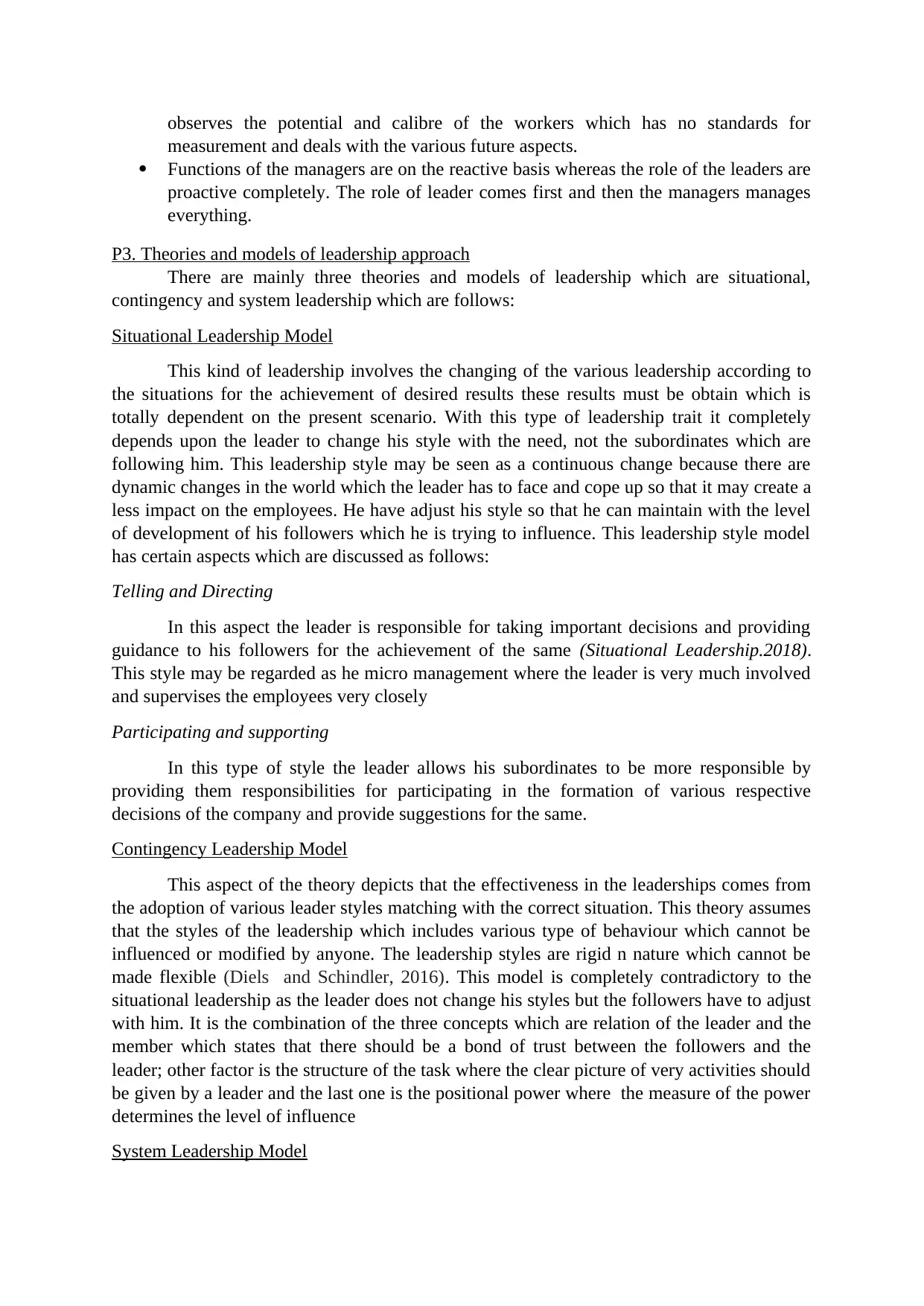
observes the potential and calibre of the workers which has no standards for
measurement and deals with the various future aspects.
Functions of the managers are on the reactive basis whereas the role of the leaders are
proactive completely. The role of leader comes first and then the managers manages
everything.
P3. Theories and models of leadership approach
There are mainly three theories and models of leadership which are situational,
contingency and system leadership which are follows:
Situational Leadership Model
This kind of leadership involves the changing of the various leadership according to
the situations for the achievement of desired results these results must be obtain which is
totally dependent on the present scenario. With this type of leadership trait it completely
depends upon the leader to change his style with the need, not the subordinates which are
following him. This leadership style may be seen as a continuous change because there are
dynamic changes in the world which the leader has to face and cope up so that it may create a
less impact on the employees. He have adjust his style so that he can maintain with the level
of development of his followers which he is trying to influence. This leadership style model
has certain aspects which are discussed as follows:
Telling and Directing
In this aspect the leader is responsible for taking important decisions and providing
guidance to his followers for the achievement of the same (Situational Leadership.2018).
This style may be regarded as he micro management where the leader is very much involved
and supervises the employees very closely
Participating and supporting
In this type of style the leader allows his subordinates to be more responsible by
providing them responsibilities for participating in the formation of various respective
decisions of the company and provide suggestions for the same.
Contingency Leadership Model
This aspect of the theory depicts that the effectiveness in the leaderships comes from
the adoption of various leader styles matching with the correct situation. This theory assumes
that the styles of the leadership which includes various type of behaviour which cannot be
influenced or modified by anyone. The leadership styles are rigid n nature which cannot be
made flexible (Diels and Schindler, 2016). This model is completely contradictory to the
situational leadership as the leader does not change his styles but the followers have to adjust
with him. It is the combination of the three concepts which are relation of the leader and the
member which states that there should be a bond of trust between the followers and the
leader; other factor is the structure of the task where the clear picture of very activities should
be given by a leader and the last one is the positional power where the measure of the power
determines the level of influence
System Leadership Model
measurement and deals with the various future aspects.
Functions of the managers are on the reactive basis whereas the role of the leaders are
proactive completely. The role of leader comes first and then the managers manages
everything.
P3. Theories and models of leadership approach
There are mainly three theories and models of leadership which are situational,
contingency and system leadership which are follows:
Situational Leadership Model
This kind of leadership involves the changing of the various leadership according to
the situations for the achievement of desired results these results must be obtain which is
totally dependent on the present scenario. With this type of leadership trait it completely
depends upon the leader to change his style with the need, not the subordinates which are
following him. This leadership style may be seen as a continuous change because there are
dynamic changes in the world which the leader has to face and cope up so that it may create a
less impact on the employees. He have adjust his style so that he can maintain with the level
of development of his followers which he is trying to influence. This leadership style model
has certain aspects which are discussed as follows:
Telling and Directing
In this aspect the leader is responsible for taking important decisions and providing
guidance to his followers for the achievement of the same (Situational Leadership.2018).
This style may be regarded as he micro management where the leader is very much involved
and supervises the employees very closely
Participating and supporting
In this type of style the leader allows his subordinates to be more responsible by
providing them responsibilities for participating in the formation of various respective
decisions of the company and provide suggestions for the same.
Contingency Leadership Model
This aspect of the theory depicts that the effectiveness in the leaderships comes from
the adoption of various leader styles matching with the correct situation. This theory assumes
that the styles of the leadership which includes various type of behaviour which cannot be
influenced or modified by anyone. The leadership styles are rigid n nature which cannot be
made flexible (Diels and Schindler, 2016). This model is completely contradictory to the
situational leadership as the leader does not change his styles but the followers have to adjust
with him. It is the combination of the three concepts which are relation of the leader and the
member which states that there should be a bond of trust between the followers and the
leader; other factor is the structure of the task where the clear picture of very activities should
be given by a leader and the last one is the positional power where the measure of the power
determines the level of influence
System Leadership Model
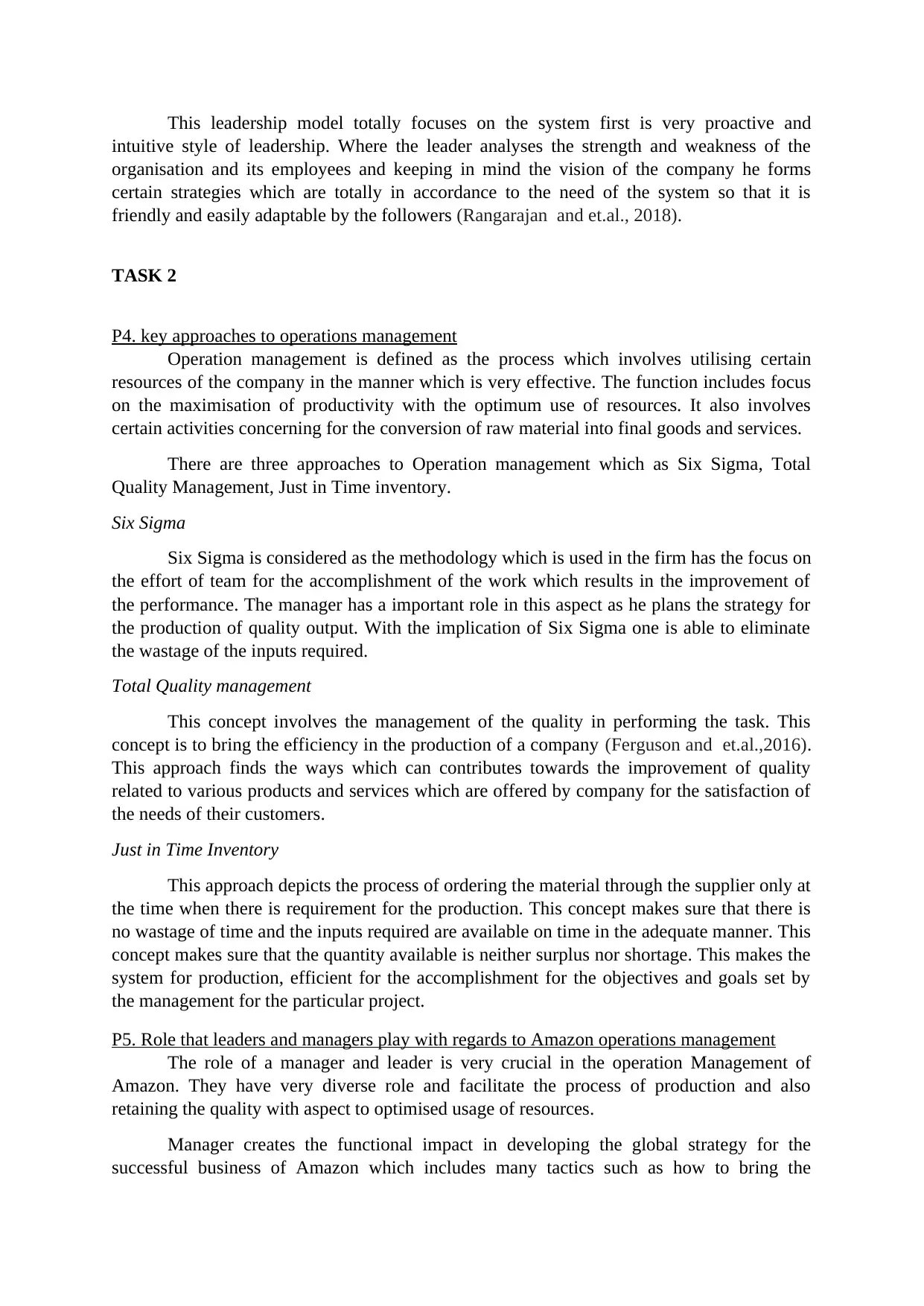
This leadership model totally focuses on the system first is very proactive and
intuitive style of leadership. Where the leader analyses the strength and weakness of the
organisation and its employees and keeping in mind the vision of the company he forms
certain strategies which are totally in accordance to the need of the system so that it is
friendly and easily adaptable by the followers (Rangarajan and et.al., 2018).
TASK 2
P4. key approaches to operations management
Operation management is defined as the process which involves utilising certain
resources of the company in the manner which is very effective. The function includes focus
on the maximisation of productivity with the optimum use of resources. It also involves
certain activities concerning for the conversion of raw material into final goods and services.
There are three approaches to Operation management which as Six Sigma, Total
Quality Management, Just in Time inventory.
Six Sigma
Six Sigma is considered as the methodology which is used in the firm has the focus on
the effort of team for the accomplishment of the work which results in the improvement of
the performance. The manager has a important role in this aspect as he plans the strategy for
the production of quality output. With the implication of Six Sigma one is able to eliminate
the wastage of the inputs required.
Total Quality management
This concept involves the management of the quality in performing the task. This
concept is to bring the efficiency in the production of a company (Ferguson and et.al.,2016).
This approach finds the ways which can contributes towards the improvement of quality
related to various products and services which are offered by company for the satisfaction of
the needs of their customers.
Just in Time Inventory
This approach depicts the process of ordering the material through the supplier only at
the time when there is requirement for the production. This concept makes sure that there is
no wastage of time and the inputs required are available on time in the adequate manner. This
concept makes sure that the quantity available is neither surplus nor shortage. This makes the
system for production, efficient for the accomplishment for the objectives and goals set by
the management for the particular project.
P5. Role that leaders and managers play with regards to Amazon operations management
The role of a manager and leader is very crucial in the operation Management of
Amazon. They have very diverse role and facilitate the process of production and also
retaining the quality with aspect to optimised usage of resources.
Manager creates the functional impact in developing the global strategy for the
successful business of Amazon which includes many tactics such as how to bring the
intuitive style of leadership. Where the leader analyses the strength and weakness of the
organisation and its employees and keeping in mind the vision of the company he forms
certain strategies which are totally in accordance to the need of the system so that it is
friendly and easily adaptable by the followers (Rangarajan and et.al., 2018).
TASK 2
P4. key approaches to operations management
Operation management is defined as the process which involves utilising certain
resources of the company in the manner which is very effective. The function includes focus
on the maximisation of productivity with the optimum use of resources. It also involves
certain activities concerning for the conversion of raw material into final goods and services.
There are three approaches to Operation management which as Six Sigma, Total
Quality Management, Just in Time inventory.
Six Sigma
Six Sigma is considered as the methodology which is used in the firm has the focus on
the effort of team for the accomplishment of the work which results in the improvement of
the performance. The manager has a important role in this aspect as he plans the strategy for
the production of quality output. With the implication of Six Sigma one is able to eliminate
the wastage of the inputs required.
Total Quality management
This concept involves the management of the quality in performing the task. This
concept is to bring the efficiency in the production of a company (Ferguson and et.al.,2016).
This approach finds the ways which can contributes towards the improvement of quality
related to various products and services which are offered by company for the satisfaction of
the needs of their customers.
Just in Time Inventory
This approach depicts the process of ordering the material through the supplier only at
the time when there is requirement for the production. This concept makes sure that there is
no wastage of time and the inputs required are available on time in the adequate manner. This
concept makes sure that the quantity available is neither surplus nor shortage. This makes the
system for production, efficient for the accomplishment for the objectives and goals set by
the management for the particular project.
P5. Role that leaders and managers play with regards to Amazon operations management
The role of a manager and leader is very crucial in the operation Management of
Amazon. They have very diverse role and facilitate the process of production and also
retaining the quality with aspect to optimised usage of resources.
Manager creates the functional impact in developing the global strategy for the
successful business of Amazon which includes many tactics such as how to bring the
⊘ This is a preview!⊘
Do you want full access?
Subscribe today to unlock all pages.

Trusted by 1+ million students worldwide
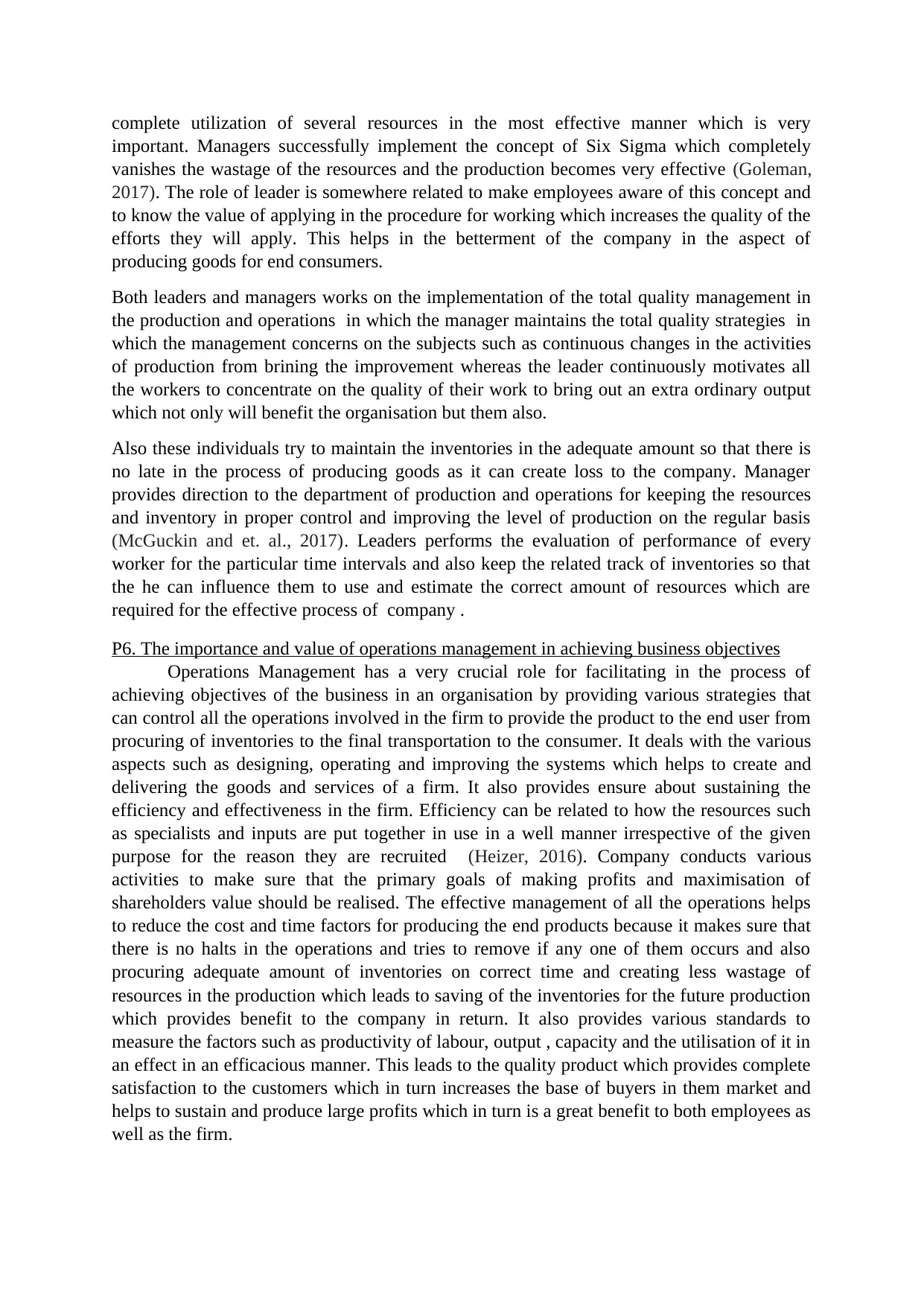
complete utilization of several resources in the most effective manner which is very
important. Managers successfully implement the concept of Six Sigma which completely
vanishes the wastage of the resources and the production becomes very effective (Goleman,
2017). The role of leader is somewhere related to make employees aware of this concept and
to know the value of applying in the procedure for working which increases the quality of the
efforts they will apply. This helps in the betterment of the company in the aspect of
producing goods for end consumers.
Both leaders and managers works on the implementation of the total quality management in
the production and operations in which the manager maintains the total quality strategies in
which the management concerns on the subjects such as continuous changes in the activities
of production from brining the improvement whereas the leader continuously motivates all
the workers to concentrate on the quality of their work to bring out an extra ordinary output
which not only will benefit the organisation but them also.
Also these individuals try to maintain the inventories in the adequate amount so that there is
no late in the process of producing goods as it can create loss to the company. Manager
provides direction to the department of production and operations for keeping the resources
and inventory in proper control and improving the level of production on the regular basis
(McGuckin and et. al., 2017). Leaders performs the evaluation of performance of every
worker for the particular time intervals and also keep the related track of inventories so that
the he can influence them to use and estimate the correct amount of resources which are
required for the effective process of company .
P6. The importance and value of operations management in achieving business objectives
Operations Management has a very crucial role for facilitating in the process of
achieving objectives of the business in an organisation by providing various strategies that
can control all the operations involved in the firm to provide the product to the end user from
procuring of inventories to the final transportation to the consumer. It deals with the various
aspects such as designing, operating and improving the systems which helps to create and
delivering the goods and services of a firm. It also provides ensure about sustaining the
efficiency and effectiveness in the firm. Efficiency can be related to how the resources such
as specialists and inputs are put together in use in a well manner irrespective of the given
purpose for the reason they are recruited (Heizer, 2016). Company conducts various
activities to make sure that the primary goals of making profits and maximisation of
shareholders value should be realised. The effective management of all the operations helps
to reduce the cost and time factors for producing the end products because it makes sure that
there is no halts in the operations and tries to remove if any one of them occurs and also
procuring adequate amount of inventories on correct time and creating less wastage of
resources in the production which leads to saving of the inventories for the future production
which provides benefit to the company in return. It also provides various standards to
measure the factors such as productivity of labour, output , capacity and the utilisation of it in
an effect in an efficacious manner. This leads to the quality product which provides complete
satisfaction to the customers which in turn increases the base of buyers in them market and
helps to sustain and produce large profits which in turn is a great benefit to both employees as
well as the firm.
important. Managers successfully implement the concept of Six Sigma which completely
vanishes the wastage of the resources and the production becomes very effective (Goleman,
2017). The role of leader is somewhere related to make employees aware of this concept and
to know the value of applying in the procedure for working which increases the quality of the
efforts they will apply. This helps in the betterment of the company in the aspect of
producing goods for end consumers.
Both leaders and managers works on the implementation of the total quality management in
the production and operations in which the manager maintains the total quality strategies in
which the management concerns on the subjects such as continuous changes in the activities
of production from brining the improvement whereas the leader continuously motivates all
the workers to concentrate on the quality of their work to bring out an extra ordinary output
which not only will benefit the organisation but them also.
Also these individuals try to maintain the inventories in the adequate amount so that there is
no late in the process of producing goods as it can create loss to the company. Manager
provides direction to the department of production and operations for keeping the resources
and inventory in proper control and improving the level of production on the regular basis
(McGuckin and et. al., 2017). Leaders performs the evaluation of performance of every
worker for the particular time intervals and also keep the related track of inventories so that
the he can influence them to use and estimate the correct amount of resources which are
required for the effective process of company .
P6. The importance and value of operations management in achieving business objectives
Operations Management has a very crucial role for facilitating in the process of
achieving objectives of the business in an organisation by providing various strategies that
can control all the operations involved in the firm to provide the product to the end user from
procuring of inventories to the final transportation to the consumer. It deals with the various
aspects such as designing, operating and improving the systems which helps to create and
delivering the goods and services of a firm. It also provides ensure about sustaining the
efficiency and effectiveness in the firm. Efficiency can be related to how the resources such
as specialists and inputs are put together in use in a well manner irrespective of the given
purpose for the reason they are recruited (Heizer, 2016). Company conducts various
activities to make sure that the primary goals of making profits and maximisation of
shareholders value should be realised. The effective management of all the operations helps
to reduce the cost and time factors for producing the end products because it makes sure that
there is no halts in the operations and tries to remove if any one of them occurs and also
procuring adequate amount of inventories on correct time and creating less wastage of
resources in the production which leads to saving of the inventories for the future production
which provides benefit to the company in return. It also provides various standards to
measure the factors such as productivity of labour, output , capacity and the utilisation of it in
an effect in an efficacious manner. This leads to the quality product which provides complete
satisfaction to the customers which in turn increases the base of buyers in them market and
helps to sustain and produce large profits which in turn is a great benefit to both employees as
well as the firm.
Paraphrase This Document
Need a fresh take? Get an instant paraphrase of this document with our AI Paraphraser
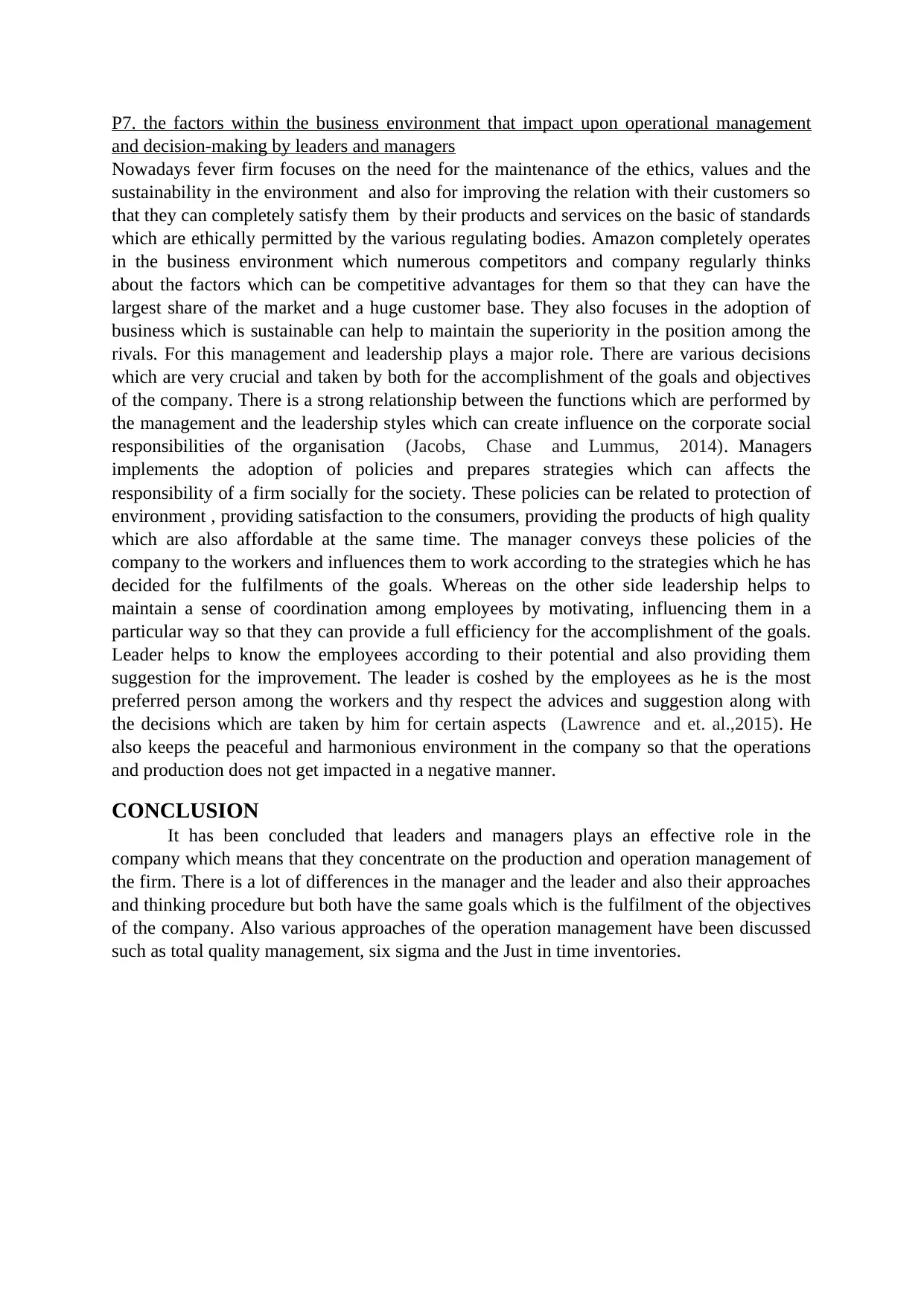
P7. the factors within the business environment that impact upon operational management
and decision-making by leaders and managers
Nowadays fever firm focuses on the need for the maintenance of the ethics, values and the
sustainability in the environment and also for improving the relation with their customers so
that they can completely satisfy them by their products and services on the basic of standards
which are ethically permitted by the various regulating bodies. Amazon completely operates
in the business environment which numerous competitors and company regularly thinks
about the factors which can be competitive advantages for them so that they can have the
largest share of the market and a huge customer base. They also focuses in the adoption of
business which is sustainable can help to maintain the superiority in the position among the
rivals. For this management and leadership plays a major role. There are various decisions
which are very crucial and taken by both for the accomplishment of the goals and objectives
of the company. There is a strong relationship between the functions which are performed by
the management and the leadership styles which can create influence on the corporate social
responsibilities of the organisation (Jacobs, Chase and Lummus, 2014). Managers
implements the adoption of policies and prepares strategies which can affects the
responsibility of a firm socially for the society. These policies can be related to protection of
environment , providing satisfaction to the consumers, providing the products of high quality
which are also affordable at the same time. The manager conveys these policies of the
company to the workers and influences them to work according to the strategies which he has
decided for the fulfilments of the goals. Whereas on the other side leadership helps to
maintain a sense of coordination among employees by motivating, influencing them in a
particular way so that they can provide a full efficiency for the accomplishment of the goals.
Leader helps to know the employees according to their potential and also providing them
suggestion for the improvement. The leader is coshed by the employees as he is the most
preferred person among the workers and thy respect the advices and suggestion along with
the decisions which are taken by him for certain aspects (Lawrence and et. al.,2015). He
also keeps the peaceful and harmonious environment in the company so that the operations
and production does not get impacted in a negative manner.
CONCLUSION
It has been concluded that leaders and managers plays an effective role in the
company which means that they concentrate on the production and operation management of
the firm. There is a lot of differences in the manager and the leader and also their approaches
and thinking procedure but both have the same goals which is the fulfilment of the objectives
of the company. Also various approaches of the operation management have been discussed
such as total quality management, six sigma and the Just in time inventories.
and decision-making by leaders and managers
Nowadays fever firm focuses on the need for the maintenance of the ethics, values and the
sustainability in the environment and also for improving the relation with their customers so
that they can completely satisfy them by their products and services on the basic of standards
which are ethically permitted by the various regulating bodies. Amazon completely operates
in the business environment which numerous competitors and company regularly thinks
about the factors which can be competitive advantages for them so that they can have the
largest share of the market and a huge customer base. They also focuses in the adoption of
business which is sustainable can help to maintain the superiority in the position among the
rivals. For this management and leadership plays a major role. There are various decisions
which are very crucial and taken by both for the accomplishment of the goals and objectives
of the company. There is a strong relationship between the functions which are performed by
the management and the leadership styles which can create influence on the corporate social
responsibilities of the organisation (Jacobs, Chase and Lummus, 2014). Managers
implements the adoption of policies and prepares strategies which can affects the
responsibility of a firm socially for the society. These policies can be related to protection of
environment , providing satisfaction to the consumers, providing the products of high quality
which are also affordable at the same time. The manager conveys these policies of the
company to the workers and influences them to work according to the strategies which he has
decided for the fulfilments of the goals. Whereas on the other side leadership helps to
maintain a sense of coordination among employees by motivating, influencing them in a
particular way so that they can provide a full efficiency for the accomplishment of the goals.
Leader helps to know the employees according to their potential and also providing them
suggestion for the improvement. The leader is coshed by the employees as he is the most
preferred person among the workers and thy respect the advices and suggestion along with
the decisions which are taken by him for certain aspects (Lawrence and et. al.,2015). He
also keeps the peaceful and harmonious environment in the company so that the operations
and production does not get impacted in a negative manner.
CONCLUSION
It has been concluded that leaders and managers plays an effective role in the
company which means that they concentrate on the production and operation management of
the firm. There is a lot of differences in the manager and the leader and also their approaches
and thinking procedure but both have the same goals which is the fulfilment of the objectives
of the company. Also various approaches of the operation management have been discussed
such as total quality management, six sigma and the Just in time inventories.
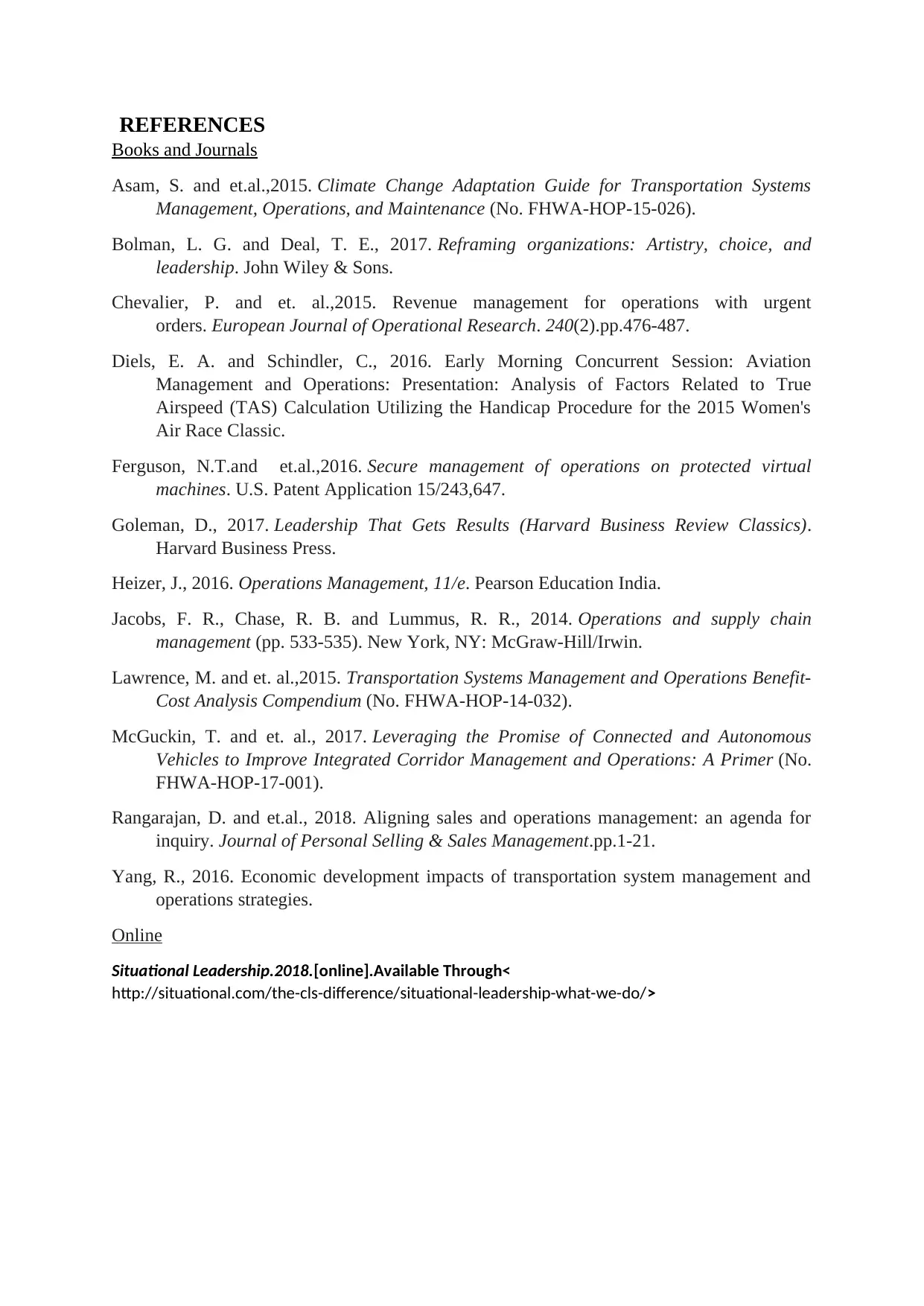
REFERENCES
Books and Journals
Asam, S. and et.al.,2015. Climate Change Adaptation Guide for Transportation Systems
Management, Operations, and Maintenance (No. FHWA-HOP-15-026).
Bolman, L. G. and Deal, T. E., 2017. Reframing organizations: Artistry, choice, and
leadership. John Wiley & Sons.
Chevalier, P. and et. al.,2015. Revenue management for operations with urgent
orders. European Journal of Operational Research. 240(2).pp.476-487.
Diels, E. A. and Schindler, C., 2016. Early Morning Concurrent Session: Aviation
Management and Operations: Presentation: Analysis of Factors Related to True
Airspeed (TAS) Calculation Utilizing the Handicap Procedure for the 2015 Women's
Air Race Classic.
Ferguson, N.T.and et.al.,2016. Secure management of operations on protected virtual
machines. U.S. Patent Application 15/243,647.
Goleman, D., 2017. Leadership That Gets Results (Harvard Business Review Classics).
Harvard Business Press.
Heizer, J., 2016. Operations Management, 11/e. Pearson Education India.
Jacobs, F. R., Chase, R. B. and Lummus, R. R., 2014. Operations and supply chain
management (pp. 533-535). New York, NY: McGraw-Hill/Irwin.
Lawrence, M. and et. al.,2015. Transportation Systems Management and Operations Benefit-
Cost Analysis Compendium (No. FHWA-HOP-14-032).
McGuckin, T. and et. al., 2017. Leveraging the Promise of Connected and Autonomous
Vehicles to Improve Integrated Corridor Management and Operations: A Primer (No.
FHWA-HOP-17-001).
Rangarajan, D. and et.al., 2018. Aligning sales and operations management: an agenda for
inquiry. Journal of Personal Selling & Sales Management.pp.1-21.
Yang, R., 2016. Economic development impacts of transportation system management and
operations strategies.
Online
Situational Leadership.2018.[online].Available Through<
http://situational.com/the-cls-difference/situational-leadership-what-we-do/>
Books and Journals
Asam, S. and et.al.,2015. Climate Change Adaptation Guide for Transportation Systems
Management, Operations, and Maintenance (No. FHWA-HOP-15-026).
Bolman, L. G. and Deal, T. E., 2017. Reframing organizations: Artistry, choice, and
leadership. John Wiley & Sons.
Chevalier, P. and et. al.,2015. Revenue management for operations with urgent
orders. European Journal of Operational Research. 240(2).pp.476-487.
Diels, E. A. and Schindler, C., 2016. Early Morning Concurrent Session: Aviation
Management and Operations: Presentation: Analysis of Factors Related to True
Airspeed (TAS) Calculation Utilizing the Handicap Procedure for the 2015 Women's
Air Race Classic.
Ferguson, N.T.and et.al.,2016. Secure management of operations on protected virtual
machines. U.S. Patent Application 15/243,647.
Goleman, D., 2017. Leadership That Gets Results (Harvard Business Review Classics).
Harvard Business Press.
Heizer, J., 2016. Operations Management, 11/e. Pearson Education India.
Jacobs, F. R., Chase, R. B. and Lummus, R. R., 2014. Operations and supply chain
management (pp. 533-535). New York, NY: McGraw-Hill/Irwin.
Lawrence, M. and et. al.,2015. Transportation Systems Management and Operations Benefit-
Cost Analysis Compendium (No. FHWA-HOP-14-032).
McGuckin, T. and et. al., 2017. Leveraging the Promise of Connected and Autonomous
Vehicles to Improve Integrated Corridor Management and Operations: A Primer (No.
FHWA-HOP-17-001).
Rangarajan, D. and et.al., 2018. Aligning sales and operations management: an agenda for
inquiry. Journal of Personal Selling & Sales Management.pp.1-21.
Yang, R., 2016. Economic development impacts of transportation system management and
operations strategies.
Online
Situational Leadership.2018.[online].Available Through<
http://situational.com/the-cls-difference/situational-leadership-what-we-do/>
⊘ This is a preview!⊘
Do you want full access?
Subscribe today to unlock all pages.

Trusted by 1+ million students worldwide
1 out of 9
Related Documents
Your All-in-One AI-Powered Toolkit for Academic Success.
+13062052269
info@desklib.com
Available 24*7 on WhatsApp / Email
![[object Object]](/_next/static/media/star-bottom.7253800d.svg)
Unlock your academic potential
Copyright © 2020–2025 A2Z Services. All Rights Reserved. Developed and managed by ZUCOL.





